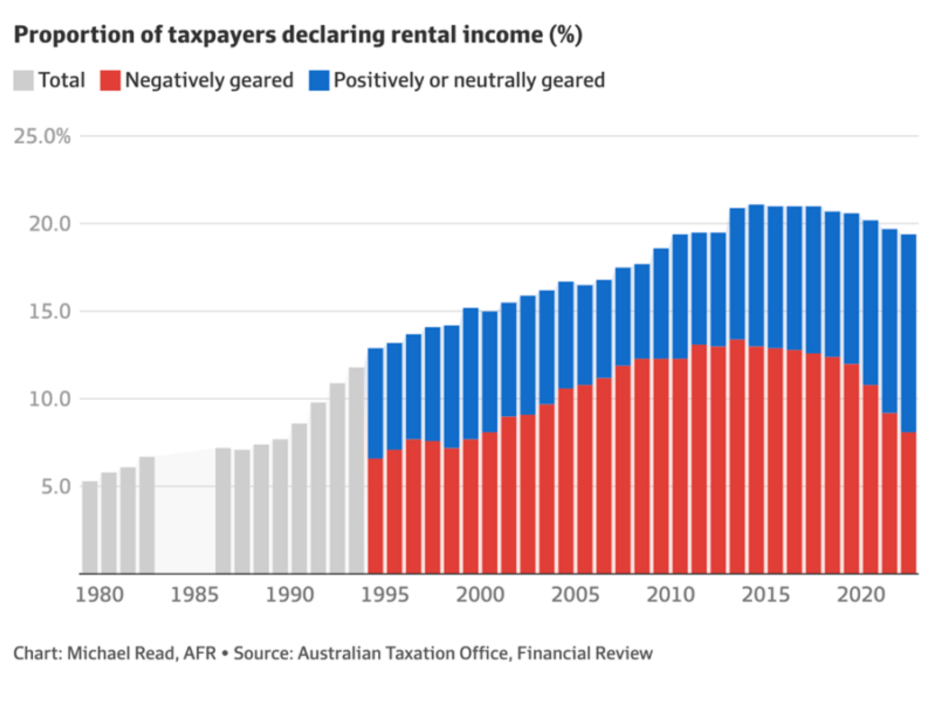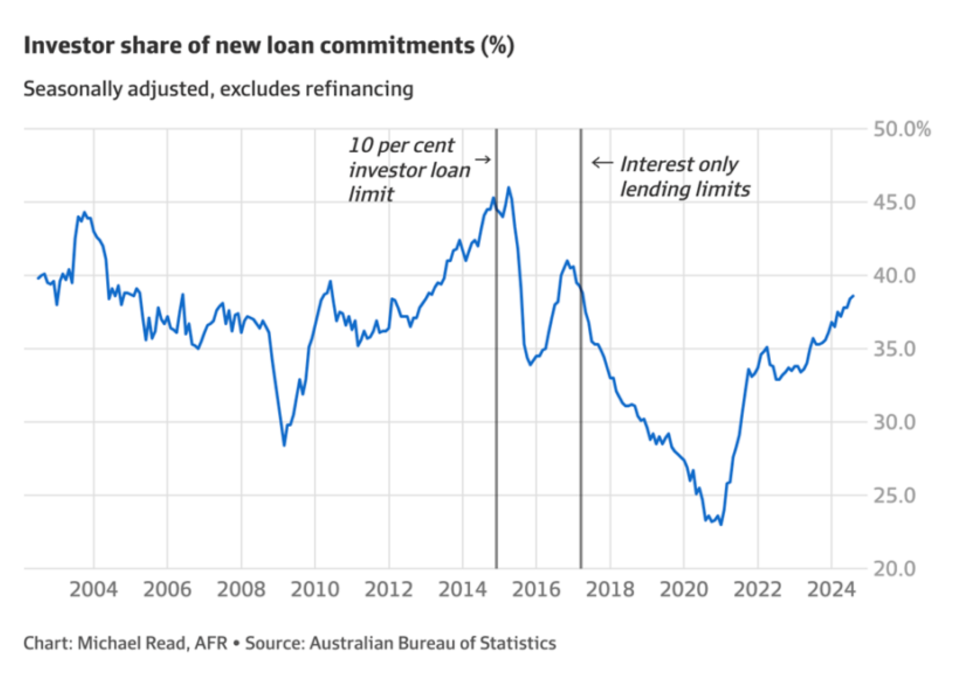.jpg?language_id=1)
As Australia contends with an increasingly severe rental housing crisis, a new trend has emerged that could exacerbate the situation-the dwindling number of private property investors.
A recent report from The Australian Financial Review warns that Australia has likely reached "peak property investor," with experts cautioning that the impacts on the rental market could be significant and long-lasting.
For decades, private investors have served as the primary providers of rental housing in Australia with the proportion of taxpayers declaring rental income quadrupling from just 5 per cent in 1980 to 21 per cent by 2014, but recent data shows a striking drop in their numbers, posing a real threat to an already strained market.

Source: AFR
The absolute number of property investors is also declining, dropping to 2.29 million in 2021-22 from a peak of 2.39 million in 2019-20.
If this trend continues, Australia's rental shortage will only become even more acute.
The numbers: a significant decline
The Australian Financial Review article highlights that the latest data from the Australian Bureau of Statistics reveals a stark drop in investor participation in the property market.
As of October, investor loans fell by 12% year-on-year, the lowest since the pandemic began, suggesting that many investors have either exited the market or are delaying further investments.
This trend follows on the heels of rising interest rates, increased regulatory scrutiny, and a series of tax changes targeting property investors.

Source: AFR
With more government interference, higher mortgage rates, and increased insurance and compliance costs, the cost of holding property has increased dramatically despite rising rents and this has caused many property investors to sell up.
At the same time, low consumer confidence and uncertainty about the future have resulted in fewer rental properties being added to the market, compounding an already critical shortage of affordable rental housing.
This has been the case, particularly in Victoria, where higher land taxes and tighter tenancy regulations have placed added pressure on investors, deterring them from the property market.
However, at Metropole, we're now seeing a reversal of this trend, with many strategic property investors seeing a window of opportunity in the Melbourne property market which has underperformed over the last couple of years.
The impact on tenants: a squeeze on rental affordability
For renters, this shift spells trouble.
As investor participation dwindles, Australia faces a dwindling supply of available rental properties, resulting in rising rents and fierce competition.
Some suburbs currently report rental vacancy rates below 1%, underscoring the intense demand for available housing.
For middle- and lower-income households, these conditions make finding affordable, long-term rentals more challenging, pushing some individuals and families to the brink of housing insecurity.
Moreover, the unaffordability of housing has broader economic consequences.
Businesses that rely on a stable, mobile workforce are finding it increasingly difficult to attract talent in high-demand areas due to the lack of affordable housing options. Without an increase in rental supply, these pressures on affordability and accessibility will likely worsen.
Why Australia needs private investors in the rental market
With the shortage in rental properties reaching critical levels, Australia urgently needs to bolster its rental housing supply.
While there are various ways to tackle this issue, one of the fastest and most effective solutions lies in encouraging private rental providers (property investors) to get back into the market.
Historically, private investors have supplied over 90% of Australia's rental housing, filling gaps that government programs couldn't.
Their presence in the market has provided a diverse, flexible, and responsive supply of rental accommodation, tailored to a range of tenant needs.
Encouraging private investment could help alleviate the immediate strain on the rental market.
But to do this, policies need to shift.
A big incentive would be to increase certainty for investors and not keep changing the rules.
Then, reducing the regulatory and tax burden on property investors, offering incentives for new rental property purchases, and creating more investor-friendly environments could make a tangible difference in enticing private investors back.
Without these reforms, the rental shortage will continue to worsen, pushing rents up further and leaving many Australians struggling to find affordable housing.
Conclusion: a clear call to action
The fall in the number of property investors isn't just a statistic; it's a symptom of larger challenges facing Australia's housing market.
Private investors have been instrumental in meeting rental demand for decades, providing housing that government schemes alone couldn't supply.
Without a substantial increase in rental property investment, we risk deepening the current housing crisis, leaving many Australians unable to access stable, affordable housing.
The solution lies in policy changes that recognise private investors as an essential part of the rental ecosystem.
By making it more attractive for investors to re-enter the market, we can build a stronger, more balanced rental supply.
This way, private property investors can once again play a leading role in providing rental accommodation for those who need it-a role they've fulfilled successfully for the last fifty years.
The current shortage underscores the urgent need to restore investor confidence, ensuring a steady flow of rental properties for Australia's growing population.
Photo by Hunters Race on Unsplash